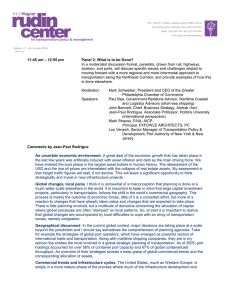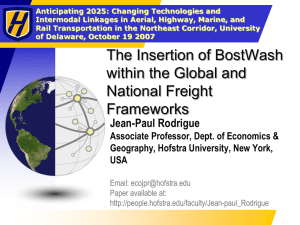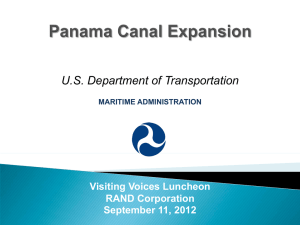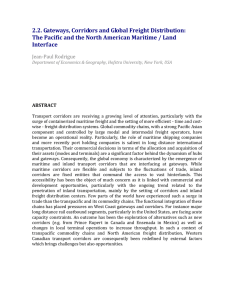Document 14176078
advertisement
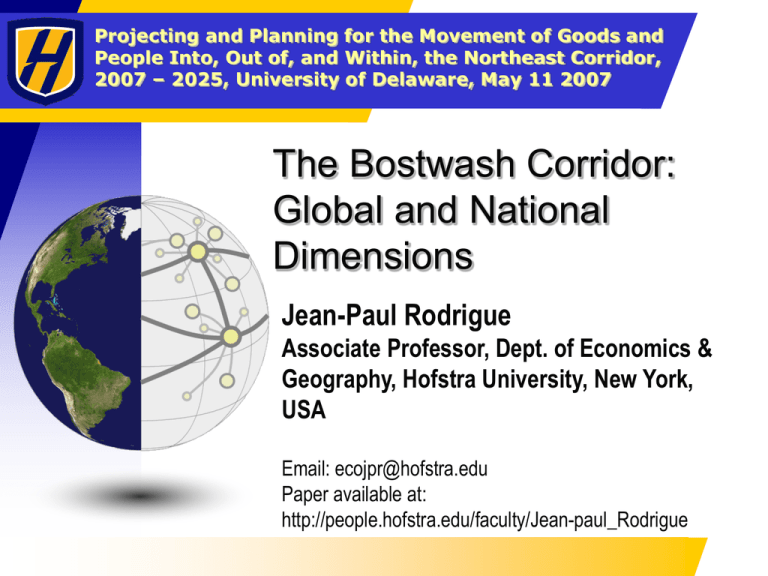
Projecting and Planning for the Movement of Goods and People Into, Out of, and Within, the Northeast Corridor, 2007 – 2025, University of Delaware, May 11 2007 The Bostwash Corridor: Global and National Dimensions Jean-Paul Rodrigue Associate Professor, Dept. of Economics & Geography, Hofstra University, New York, USA Email: ecojpr@hofstra.edu Paper available at: http://people.hofstra.edu/faculty/Jean-paul_Rodrigue Gateways and Corridors in Transportation and Regional Economics Theories and concepts about corridors Global cities and hierarchies Economic roles and functions Hinterlands Connectivity Flows and locations UPS Willow Springs Distribution Center, Chicago Types and Functions of Freight Corridors Type Function Examples Short distance (within a Modal shift, improved Switch carrying, gateway / hub) capacity and Alameda, “Agile throughput. Port”, Panama Hinterland access (between a gateway and its vicinity) Expand market area, Rail shuttles, PIDN, reduce distribution Virginia Inland port costs & congestion Landbridge (between gateways) Long distance container flows, continuity of global commodity chains Circum-hemispheric Integrated global (between gateways with transport chains a maritime segment) North American landbridge Northern EastWest Corridor Elements of the Maritime / Land Interface Maritime Freight Distribution Foreland (Shipping Network) Inland Freight Distribution Port System Gateways Road Rail Corridors and Hubs Hinterland (FDC) Coastal / Fluvial Traffic at the 50 Largest Container Ports, 2004 Tacoma Seattle Oakland Los Angeles New York/New Jersey Charleston Dubai Long Beach Jeddah Salalah Nhava Sheva Colombo Traffic 2004 (TEU) Less than 2 million 2 to 4 million Santos 4 to 7 million Durban 7 to 10 million Melbourne More than 10 million Pacific Asia Tianjin Laem Chabang Port Kalang Guangzhou Tanjung Pelepas Singapore Tanjung Priok Manila Hamburg Bremen/Bremerhafen Rotterdam Antwerp Felixstowe Dalian Quingdao Shenzhen Shanghai Yanti an Ningbo Hong Kong Kaohsiung Keelung Europe LeHavre Busan Nagoya Kobe Osaka Tokyo Yokohama Barcel ona Valencia Gioia Tauro Algeciras Three Major Pendulum Routes Serviced by OOCL, 2006 Oakland Los Angeles New York Norfolk Charleston 27 Days Hamburg Le Havre Rotterdam Southampton Genoa Fos Barcelona Tokyo Shanghai Ningbo Kaohsiung Hong Kong Laem Chabang 49 Days Atlantic Express (ATX) European Union / Mediterranean (EUM) Note: Paths are approximate South China Express (SCX) Singapore Port Kelang 39 Days Majort Port Holdings, 2007 Dedicated Maritime Container Terminals APM Terminals Dubai Ports World Hutchison Port Holdings Port of Singapore Authority Eurogate Stevedoring Services of America Pacific Asia Europe Dr. Jean-Paul Rodrigue, Dept. of Economics & Geography, Hofstra University Gateways and Hubs as Central and Intermediate Locations Intermodal Gateway ■ Gateways & hubs • Nodes offering an accessibility to a large system of circulation. • Obligatory (semi) points of passage. • Convergence of transport corridors. • Centrality and intermediacy. ■ Gateways Transmodal • Favorable physical location. • Intermodal and stable in time. ■ Hubs Hub • Transmodal and subject to change. • Commercial decisions. • Delays vs. frequency of services. Hinterland Setting and Major Economic Regions North America Western Europe Coastal concentration Landbridge connections Inland concentration Coastal gateways Hinterland intensity Freight Corridor hierarchy East and Southeast Asia Coastal concentration Low hinterland access Gateway hierarchy Gateways and Hinterland Effect Pacific Asia North American West Coast SEZ Corridor Inefficient Inland Freight Distribution Efficient Inland Freight Distribution Corridors and Regional Development B A Order High Low Specialization and High Low interdependency C Gateway Flows Supply Chains, Gateways and Corridors Global supply chains and production networks Continental integration Gateway choice APL Distribution Center, Shenzhen, China Commodity Chains and Added Value High Globalization Added value R&D Sales / Service Marketing Branding Distribution Design Concept Manufacturing Low Commodity chain Logistics Logistics and the Acceleration of Freight Speed barrier Transshipment Pull Logistics Logistical threshold Containerization Push Logistics Shipment The North American Landbridge Fraser Vancouver Tacoma Seattle Halifax Montreal Portland Minneapolis Chicago Salt Lake City New York/New Jersey Baltimore Wilmington (DE) Oakland Kansas CIty Hampton Roads Long Beach Los Angeles Charleston Savannah El Paso Jacksonville Houston New Orleans Miami Port Everglades Americ an Landbridge Canadian Landbridge Mexican Landbridge Altamira Connector Major Container Port Major Rail Freight Distribution Center Manzanillo Veracruz Gateways, Corridors and Competitiveness Emerging continental networks Trade barriers Strategic partners Interregional linkages International competition APL “Australia” entering San Francisco Harbor Beware of Future Expectations: The Fallacies of Linear Thinking (Projected TEU Traffic, Port of NY/NJ) 12 11 10 Million TEUs 9 8 7 Imports Exports Empties 6 5 4 3 2 1 0 2000 2010 2020 2030 2040 2050 2060 Are You &*%@# Out of Your Mind? Projections for Container Port Volumes, 2020 Sectors of American Imports of Asian Goods Through Maritime Container Shipping, 2004 (in TEUs) Apparel Textiles Machinery Electrical equipment Toys Shoes Tires Auto parts Appliances Electronics Furniture Big box retailer 0 300,000 600,000 900,000 1,200,000 1,500,000 1,800,000 World Container Traffic, 1980-2005, and Guesses for up to 2020 1000 900 800 Million TEU 700 600 500 400 300 200 100 0 1980 1985 1990 1995 2000 2005 2010 2015 2020 Balance of Containerized Cargo Flows along Major Trade Routes, 1995-2006 (in millions of TEUs) 0 1995 1996 -2 -4 -6 -8 -10 -12 -14 -16 -18 Europe/USA Asia/Europe Asia/USA 1997 1998 2000 2001 2002 2003 2004 2005 2006 Main North American Trade Corridors and Metropolitan Freight Centers Edmonton Calgary Vancouver Winnipeg Seattle Halifax Portland Montreal Minneapolis Toronto Boston Detroit Chicago Salt Lake City Pittsburgh Philadelphia Baltimore San Francisco Denver Cincinnati Kansas City St. Louis Norfolk Charlotte Los Angeles San Diego New York Cleveland Oklahoma Ci ty Memphis Phoenix Atl anta Charleston Dallas Hub Gateway Houston New Orleans Miami Institutional Frameworks for Governance Political jurisdictions Transport networks and corporations Trading blocs and internal free trade Harmonization of regulations and practices “Maersk Sealand” Locomotive, Landers Yard (NS), Chicago NAFTA Transborder Truck Flows and Traffic at US Ports of Entry, 2002 Is 53 the Magic Number? ■ New container specifications? • Economies of scale push towards a larger container: • Particularly for inland carriers. • Strong “legacy costs” (inertia): • Accumulated investments in modal and intermodal infrastructure. • The North American vs. the European standard: • • • • ISO 40 footer: 12.027 m x 2.33 m. NA domestic 53 footer: 16.15 m x 2.4 m. European Intermodal Load Unit: 13.2 m x 2.4 m. China will play a significant role in the decision. • The bottom line is likely to be the size that can be fitted on road transport systems, so 53 could be the “magic number”. Carrying Capacity of Containers (in cubic feet) 53 feet truck 4,090 53 feet hi-cube container 3,955 53 feet standard container 3,830 48 feet standard container 3,471 45 feet standard container 3,026 EILU Long 45 2,895 40 feet hi-cube container 2,690 40 feet standard container 2,385 20 feet standard container 1,169 0 500 1,000 1,500 2,000 2,500 3,000 3,500 4,000 4,500 Public and Private Investments in Gateways and Corridors Financing corridor and gateway development Co-production and cooperation Bottleneck mitigation Multimodal Infrastructure Inland ports Regulatory preferences Fiscal regimes Translisft crane, NS Rutherford yard, PA Level of Congestion of the Interstate Highway System Potential Location of Major Transmodal Rail Facilities: Maritime Gateways and Inland Hubs Calgary Vancouver Seattle Regina Winnipeg Tacoma Montreal Minneapolis Chicago Oakland Kansas City New York/New Jersey St Louis Hampton Roads Memphis Long Beach Los Angeles Dallas / Fort Worth Houston Charleston Savannah Maritime Rail Gateway Transmodal Rail Hub Dr. Jean-Paul Rodrigue, Dept. of Economics & Geography, Hofstra University Boston – Washington Corridor: Volume to Capacity Ratio Port Inland Distribution Network and Freight Clusters Circum Hemispheric Dreams Vostochny Oakland Harbin Long Beach Un ite d S tate s Salt Lake City Tacoma Vancouver Lianyungang Beijing Port Gauge Change El Paso Zabaykalsk Rail Terminal Canada China Ulaanbaatar Arctic Bridge Irkutsk Northern Sea Route Lanzhou Mongolia Northwest Passage Houston Kansas CIty Russia Minneapolis Chicago Urumqi Novosibirsk Lokot Savannah New York Astana Montreal New York Yekat erinburg Perm' Halifax Archangel'sk Haparanda/Tornio Oulu Vologda Vainikkala St. Petersburg Moscow Maritime Segment Rail Main Trunk (Broad Gauge) Rail Main Trunk (Standard Gauge) Azimuthal Equidistant Polar Projection Rotterdam Brest Presnogorkovka Kazakhstan Druzhba
